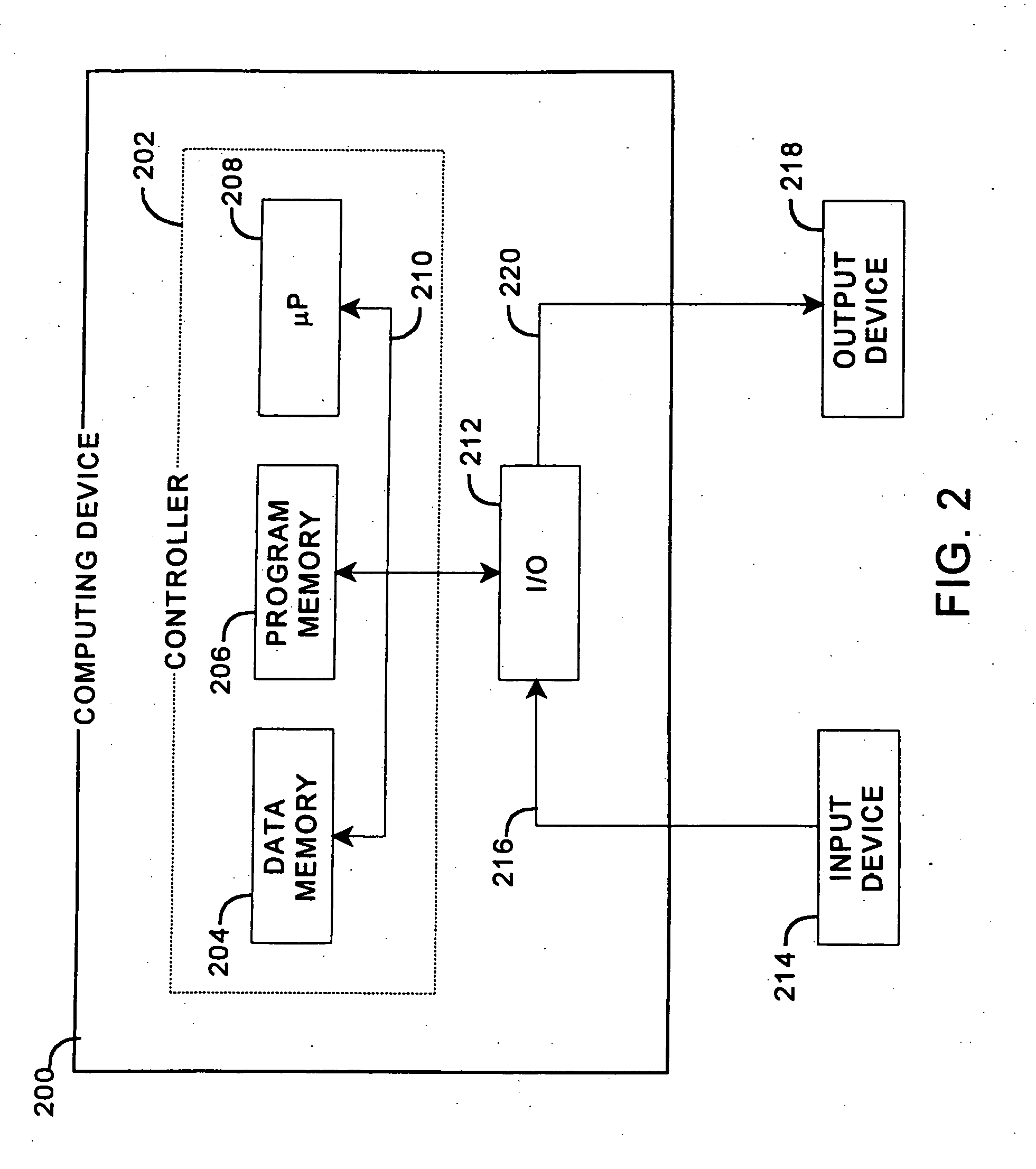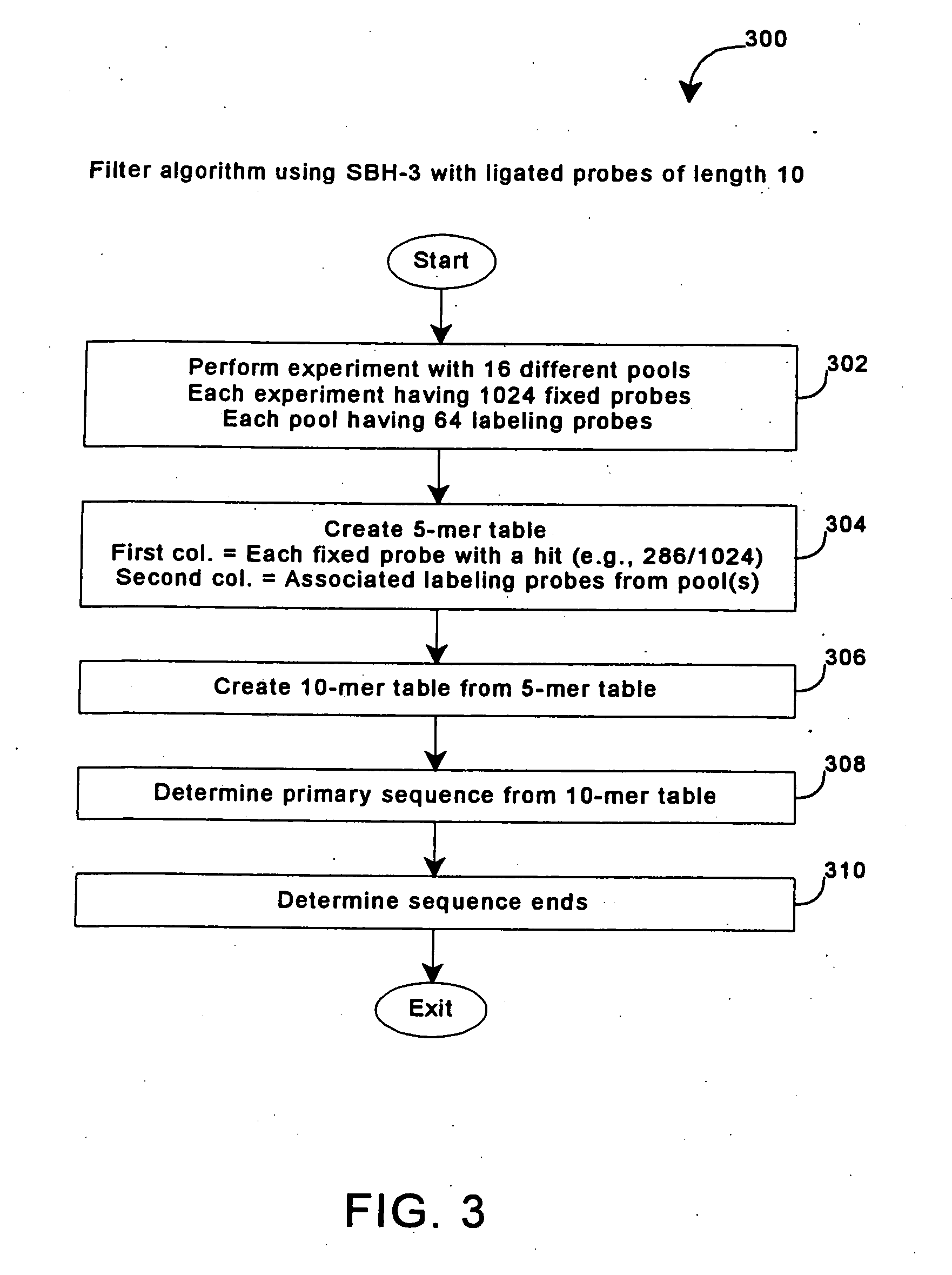Enhanced sequencing by hybridization using pools of probes
a technology of pooled probes and hybridization, which is applied in the field of nucleic acid sequence analysis using sequence analysis by hybridization, can solve the problems of insufficient information available to decide, speed and cost efficiency not available with other sequencing methods, and the difficulty of determining the sequence of the four nucleotides in nucleic acid samples, so as to improve the efficiency of conducting sbh and reduce the level of redundancy. r
- Summary
- Abstract
- Description
- Claims
- Application Information
AI Technical Summary
Benefits of technology
Problems solved by technology
Method used
Image
Examples
example 1
Computer Simulation Using Pools of 10-Mer Probes in Format 3 SBH
[0237] Computer simulations were used to test the described methods. The simulations used Format 3 SBH with 16 pools of 64 5-mers or 32 pools of 32 labeled 5-mers and 16 or 32 full arrays of 1024 fixed 5-mers, respectively. The pools were generated to satisfy various constrains: no reverse complements, no shifts where the first four nucleotides of one probe match the last four nucleotides of the other probe, no pairs of probes in a pool with single nucleotide difference, and minimized number of pairs with only two differences. The simulations tested different randomly generated 300 nucleotide and 1000 nucleotide targets. To simulate actual conditions, some simulations contained randomly generated 30-100% false positive scores.
[0238] The simulated raw hybridization data was then used to generate sequence information, according to the following algorithm: For each fixed 5-mer that is positive with a given pool, all poss...
example 2
Analysis of Single Nucleotide Polymorphisms Using Pools of Probes
[0243] Format 3 SBH was carried out using a complete set of 1,048,576 10-mer probes scored for full match hybrids in a DNA sample, by hybridizing and ligating 16 pools of 64 labeled 5-mers on 16 replica arrays containing the full complement of 1024 attached 5-mers. Different DNA targets 100-220 bases in length were successfully sequenced using this procedure.
[0244] A 135 bp fragment of the human cytochrome P 450 (CP450) gene with 67.4% G+C content (corresponding to positions 3358-3492 of the sequence deposited under Genbank Accession No. CP450 CYP206) was prepared from genomic DNA using PCR. The CP450 gene has an A / G polymorphism at position 109 of the fragment, and the DNA sample used was heterozygous for this polymorphism, so that the DNA obtained from the sample had both possible sequences. One primer was phosphorylated, to allow degradation of that strand by lambda exonuclease (GIBCO BRL, used according to suppli...
example 3
Computer Simulation of SBH Using 16,384 Pools of 1024 12-Mers to Assemble 3.2 kb Target Sequences
[0251] Simulation experiments with pools of 12-mers demonstrated the potential of this SBH approach to determine the sequence of very long target nucleic acid sequences of more than 10 kb in length. (See Table 3 above). Several sequence assembly experiments were conducted with simulated data and pools of 10-mer or 12-mers to measure the minimal redundancy factor for different probe lengths and target nucleic acid lengths.
[0252] First, by using 16,384 pools of 64 10-mers, an Fp of 1 / 5 or less was observed to be sufficient to assemble 800 bases with a success rate similar to that using individual, unpooled probes (in about 90% cases, see Table 1). In addition, there were a large number of false positive pools (pools whose hybridization scores were considered positive despite the fact that they contained no full match probes), e.g., due to random experimental error. Since both true positi...
PUM
| Property | Measurement | Unit |
|---|---|---|
| width | aaaaa | aaaaa |
| distance | aaaaa | aaaaa |
| threshold number | aaaaa | aaaaa |
Abstract
Description
Claims
Application Information
 Login to View More
Login to View More - R&D
- Intellectual Property
- Life Sciences
- Materials
- Tech Scout
- Unparalleled Data Quality
- Higher Quality Content
- 60% Fewer Hallucinations
Browse by: Latest US Patents, China's latest patents, Technical Efficacy Thesaurus, Application Domain, Technology Topic, Popular Technical Reports.
© 2025 PatSnap. All rights reserved.Legal|Privacy policy|Modern Slavery Act Transparency Statement|Sitemap|About US| Contact US: help@patsnap.com



